The Intel Haswell-E CPU Review: Core i7-5960X, i7-5930K and i7-5820K Tested
by Ian Cutress on August 29, 2014 12:00 PM ESTOverclocked Results
As part of our reviews here at AnandTech we have recently been including a section on overclocked results, because in the end a +10% overclock does not always mean an extra +10% on performance. For our overclocking escapades mentioned earlier in the review, while we were able to achieve 4.6 GHz on the Core i7-5960X, the sweet spot was around 4.3 GHz at a very comfortable temperature. This leads to a +43% overclock over the base frequency, similar to what we saw with Sandy Bridge-E overclocking.
For our overclocking tests, we are using the same graphs as in the last two pages, but adding the data from our overclocked Sandy Bridge-E, Ivy Bridge-E, Haswell and Haswell-E CPUs as well, tested fresh for this review on our latest benchmark suite.
In the past overclocking was all about getting the same or better performance for a lower cost, however with Ivy Bridge-E due to its lower frequency, it was a battle to keep on par with Sandy Bridge-E. Now that Haswell-E has the same frequency deficit (200 MHz) but a +8% increase in IPC, it begs the question if Sandy Bridge-E users with good 4.8 GHz+ CPUs should consider upgrading (for anything other than more cores and an upgraded chipset).
SYSmark 2014

SYSmark sees the biggest uplift in its media and office benchmark suites when overclocked, although the financial suite does enjoy the more cores to put the 5960X ahead.
HandBrake v0.9.9: link
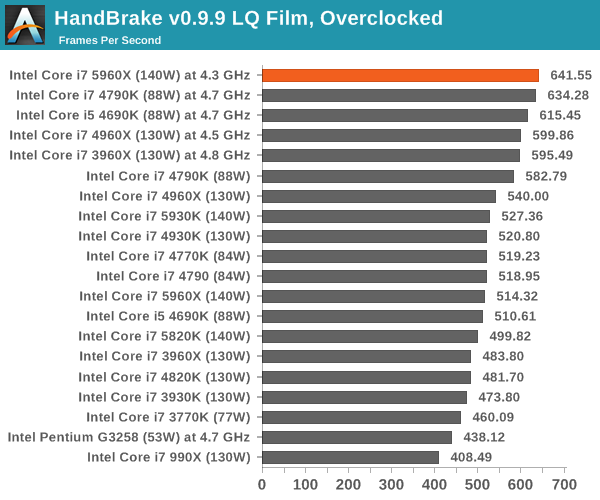
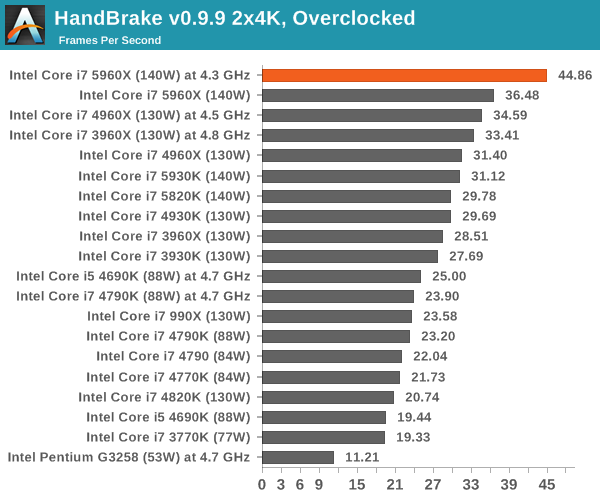
Interestingly the overclocked 5960X does aid low quality conversion, showing that with enough frequency all the cores can be constantly fed with data. The 5960X takes the top two spots for 4K conversion.
Agisoft Photoscan – 2D to 3D Image Manipulation: link

Photoscan also enjoys overclocking in combination with the cores, but the 3960X overclocked will beat the 5960X at stock despite the extra cores of the 5960X.
Dolphin Benchmark: link
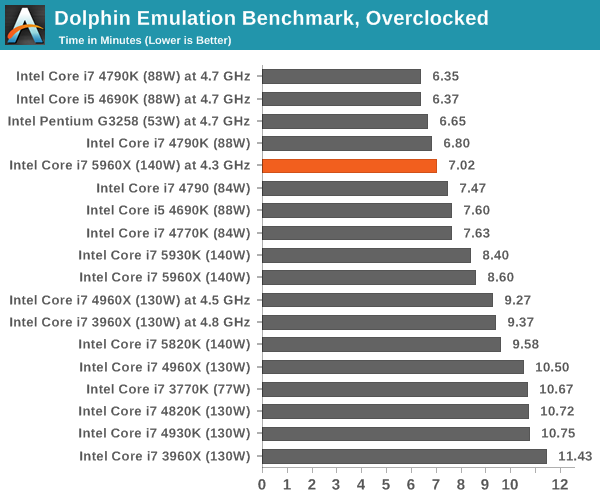
Dolphin prefers single threaded speed, so the Haswell CPUs at 4.7 GHz win here. Haswell does well in Dolphin's emulation overall, hence why the older extreme processors, even when overclocked, are further down.
WinRAR 5.0.1: link
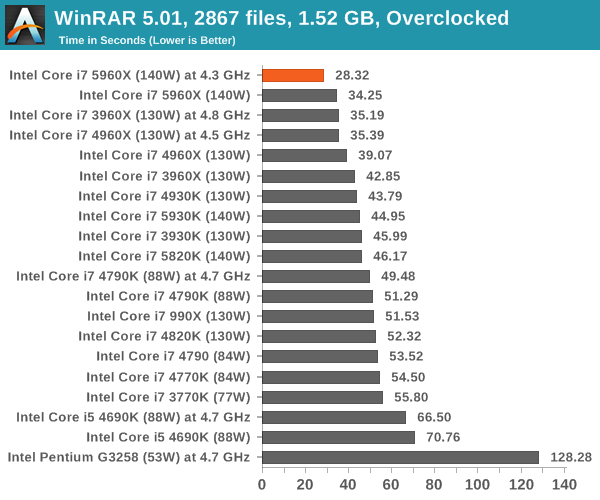
More top spots for the 5960X, with the two extra cores at stock beating the other extreme processors.
Hybrid x265
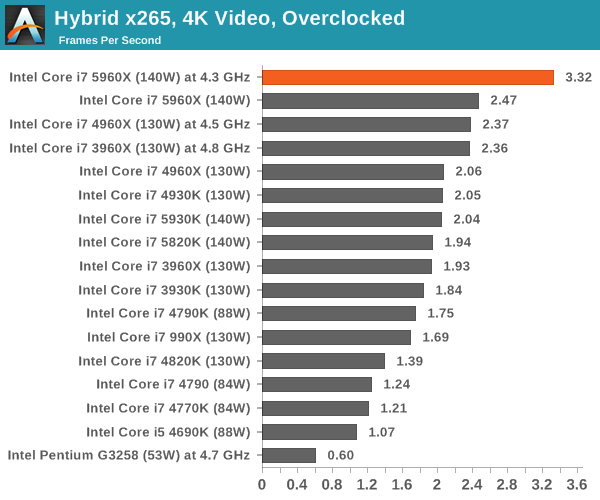
Cinebench R15
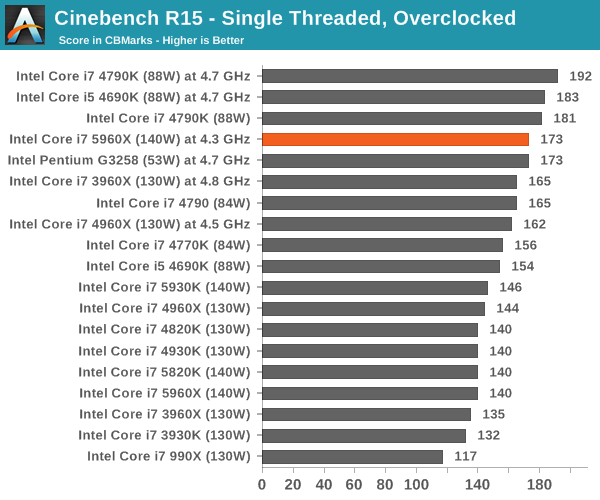
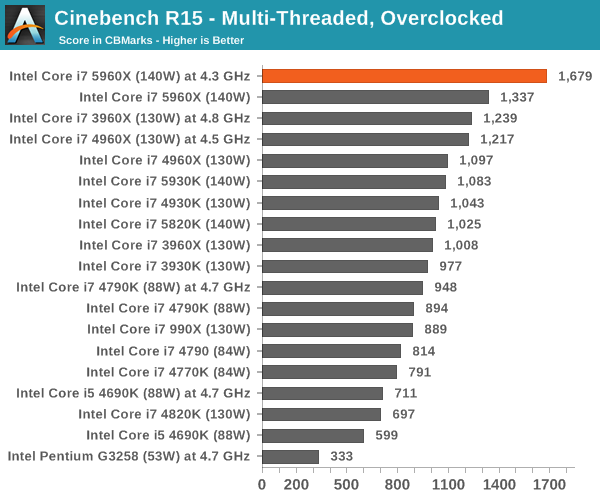
3D Particle Movement
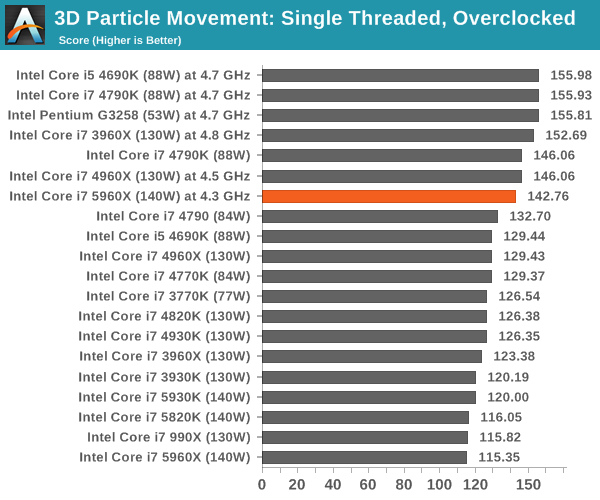
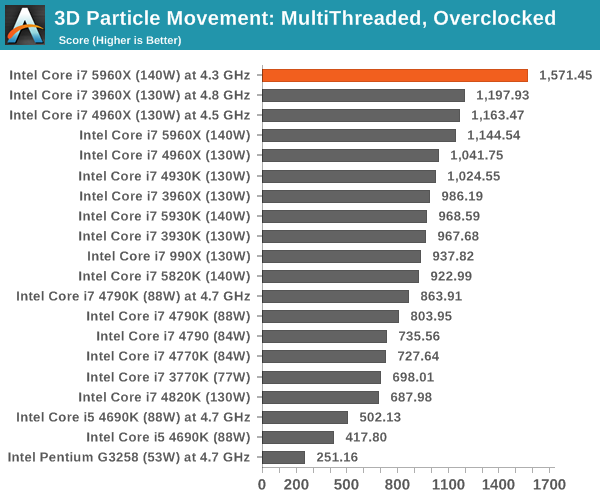
FastStone Image Viewer 4.9

When overclocked to 4.3 GHz, the 5960X would seem to produce a similar experience in FastStone to the 4790K at stock. This makes sense as the 4790K at stock is 4.4 GHz in turbo mode.
POV-Ray 3.7 Beta RC14
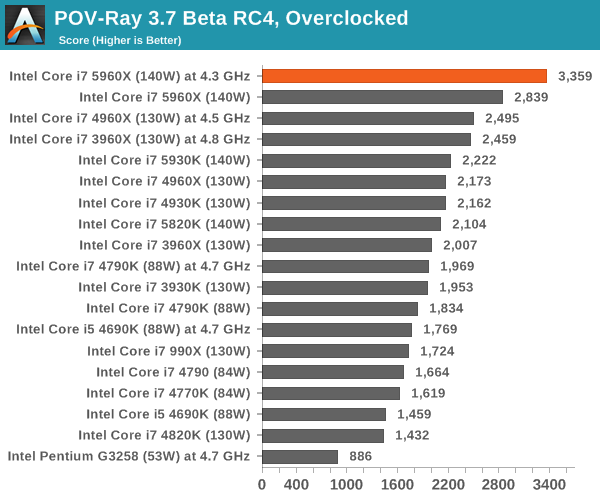
Gaming Benchmarks
F1 2013

The overclocked 5960X scores a few points in minimum frame rates, giving another +20% while in SLI.
Bioshock Infinite
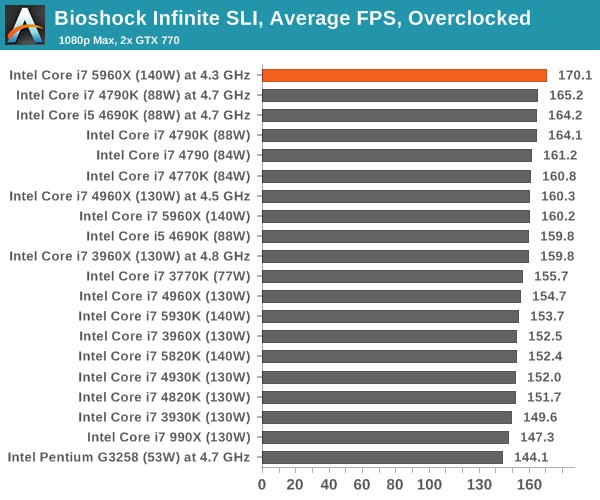
Bioshock average frame rates seem to get a small boost when overclocked, but minimum frame rates are more responsive to the 84W and 88W parts. The variation might be more indicative of the benchmark as a whole, as it only takes one errant slow frame to produce a low result in the minimum FPS results.
Tomb Raider
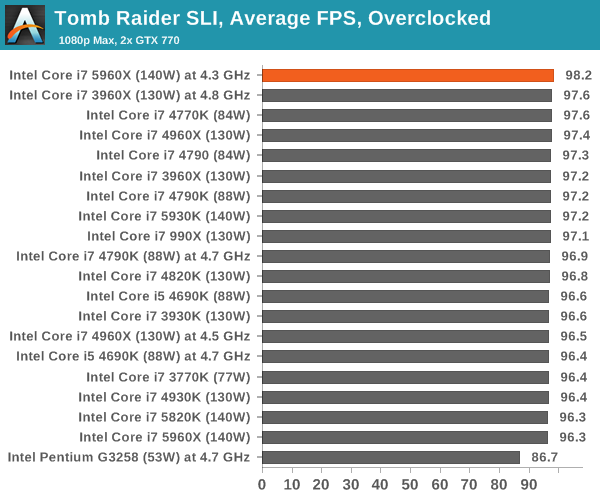
Sleeping Dogs
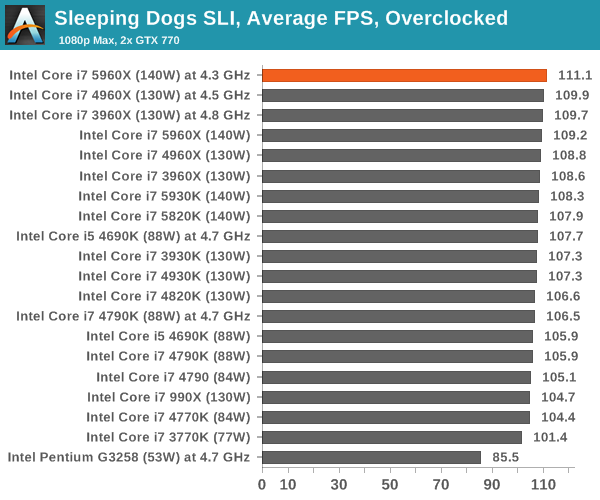
Battlefield 4
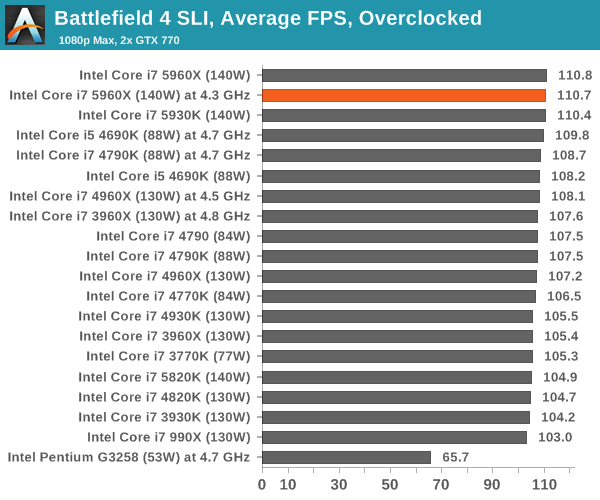
















203 Comments
View All Comments
MrBungle123 - Friday, August 29, 2014 - link
Is there anything but 'edge case' justification for upgrading any more? PCs used to be exciting because things were always changing, this is just getting boring.edzieba - Friday, August 29, 2014 - link
VR. The frame rendering time requirements are pretty stringent. This is more on the GPU than the CPU for graphics, but you want to try and keep physics tics at a good rate to prevent objects jumping around the world.tech6 - Friday, August 29, 2014 - link
Even the 'edge case' is not longer a slam dunk as most workstation workloads like CAD do very well on the 4960X.The only real cases are heavy scientific number crunching, animation rendering and cracking password hashes by brute force.
MrBungle123 - Friday, August 29, 2014 - link
It used to be that if you were 2 generations behind your system was so slow and irrelevant that you just couldn't run modern software at anything approaching an acceptable level. Now we have a situation where ancient systems on X58 (circa 2008) are still close enough in performance to the extreme high end in 2014 to not only be in this review but also fit somewhere into the top half of the product stack of modern Haswell based hardware.If you compare a top of the line Nehalem chip to its equivalent from 6 years prior (a Northwood core P4 from 2002) it would make a mockery of 8 of them at the same time. This article is saying a 31% jump from Nehalem to Haswell-E -- that kind of performance increase (as a percentage) would have amounted to 2 or 3 months worth of clock speed bumps at any other time in the history of PCs.
wireframed - Friday, August 29, 2014 - link
Somewhat true, but consider that you get 30% IPC increase, 25-30% frequency increase and a 50% core-count increase, and it adds up to around a 100% increase in performance.Granted, 100-110% over 6 years is hardly impressive compared to earlier, but there isn't that much low-hanging fruit.
Also, the mainstream which drives revenue is, as you point out, largely content. They're looking at adding devices like tablets and consoles, instead of upgrading their computers. That probably plays into the amount of R&D Intel decides to spend on the HEDT platform.
Kain_niaK - Friday, August 29, 2014 - link
Exactly exactly exactly! I am still on X58 with a i7 990x. I don't play much games any more but even to play the newest games ... I do not need to upgrade my CPU and have not needed to upgrade my CPU since 2010. And even my i7 975x or a i7 920 from 2008 would still be more then fast enough. Then music. I use my system mainl as Digital Audio Workstation. Most of my plugins and music applications support multithreading. I cannot realistically ad so much stuff to a project that it maxes out the CPU. And rendering time? Who cares, most of my renders are done before I am done playing chess on the toilet anyway. Then overclocking. The i7 920 and anything on X58 was great. After that ... the fun and the excitement kind of went away and has never come back. What's the SUPERPI MOD record these days? I have not heard about any significant record breaking for a long time. Back in 2008, 2009,2010 I was hearing news about famous new overclock records. After that, it stopped. Let's face it. We hit a clock limit and for a breaktrought in singlethreated speed ... it's just not gonna happen until some genius designs a totally different system. Probably not using electricity but light. But that's like 20 years away because you don't just start over. All we have been doing is improving old technology not inventing something completely new. We are hitting the limits of nature ... so all the geeks and the nerds will just have to way at least another 10 years before we get to the exciting stuff again.MrBungle123 - Friday, August 29, 2014 - link
At this rate 10 years from now any Haswell i7 is still going to be within spitting distance of whatever the best is. lolIf you wan't Skylake performance today OC your Haswell by 250MHz, Ivy Bridge by 400MHz, or Sandy Bridge by 600MHz.
Laststop311 - Saturday, August 30, 2014 - link
it wont be the cpu performance difference that makes u upgrade it will be the new features. Skylake will have pci-e 4.0 and usb 3.1 and then chipsets after that will add more new things faster storage standards and who knows what else.I was already in this position. The speed of the i7-980x was still rly good. Got mine oc'd to 4261mhz. But guess what on x58 you get not pci-e3.0 no sata 3 no usb 3.0. These features have become very standard. You also get no sata express or pci-e ultra m2 which will soon be commonplace as well as no quad channel memory and no ddr4. All the missing features made me upgrade, not the speed. Similar situations in the future will cause people to upgrade every 4-6 years.
TiGr1982 - Tuesday, September 2, 2014 - link
You can still plug the PCIe USB 3.0 extension board there and get at least 2 USB 3.0 ports on the back of the case, to somewhat mitigate the age of the platform.But, with PCIe 2.0 and SATA 2, one is stuck, indeed.
actionjksn - Saturday, August 30, 2014 - link
Nehalm was great, but the last big bump was really Sandy Bridge. After that, not so much. This is actually a big concern for the processor makers. The technology and the silicon itself is reaching its limits as far as making significant gains on the next generations. They were getting big performance gains from just die shrinks alone, but those days are over. And how much more can they shrink them? It's getting harder all the time, they may get to 7nm to 10nm.